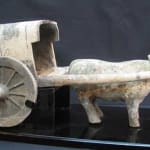Han Dynasty Painted Pottery Bull Cart, 206 BCE - 220 CE
Terracotta
17 x 9
DL.2064
During the Han Dynasty sculptural effigies of domesticated animals were often interred in the tombs of nobility and elite members of the social hierarchy. Created in all media, these sculptures...
During the Han Dynasty sculptural effigies of domesticated animals were often interred in the tombs of nobility and elite members of the social hierarchy. Created in all media, these sculptures accompanied the spirit of the deceased into the afterlife. Similar examples of oxen exist, discovered buried as part of a herd, contained inside a sculpted miniature pen with other domesticated animals, suggesting that they served as nourishment. However, this bull, pulling a cart behind him, clearly functioned as a beast of burden that was to perform onerous chores throughout eternity. Besides its function, this sculpture is also remarkable for its exquisite state of preservation. Remnants of the original paint that once decorated the work are visible on the sides of the cart and the animal’s face. Such delicate pigments rarely survive the ravages of time and the stresses of excavation. The cart is a masterpiece unto itself, composed of three separate pieces: the cart structure and two wheels with spokes. During the Han Dynasty, the Chinese believed that the afterlife was a continuation of our earthly existence. Thus, this bull and cart was entombed in place of the real thing in order to provide for the transport needs of the deceased as he journeys through the afterlife. This work is more than a mere sculpture; it is a gorgeous memorial to the religious and philosophical beliefs of the Han Dynasty.



